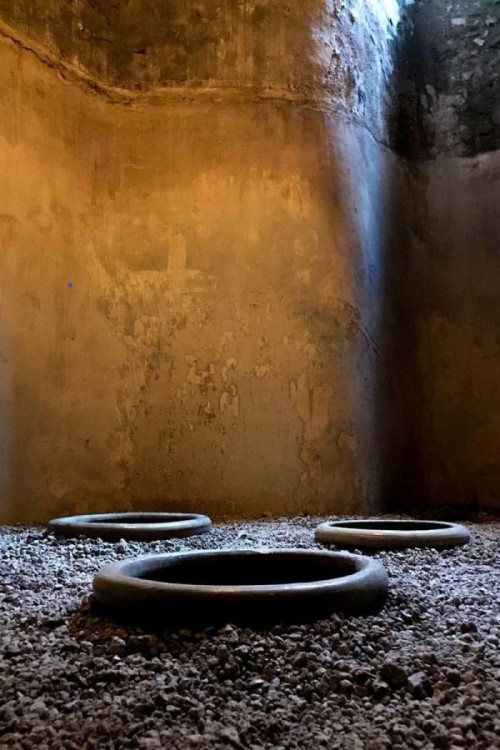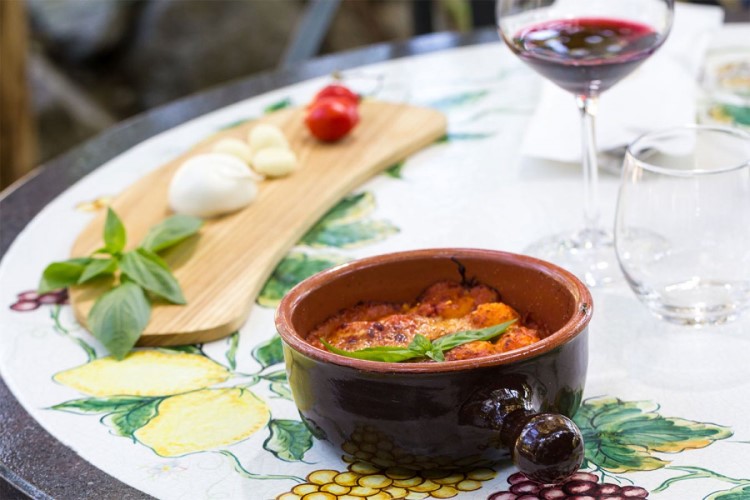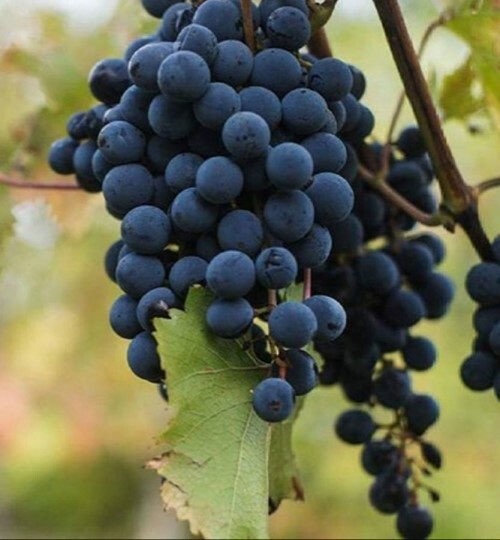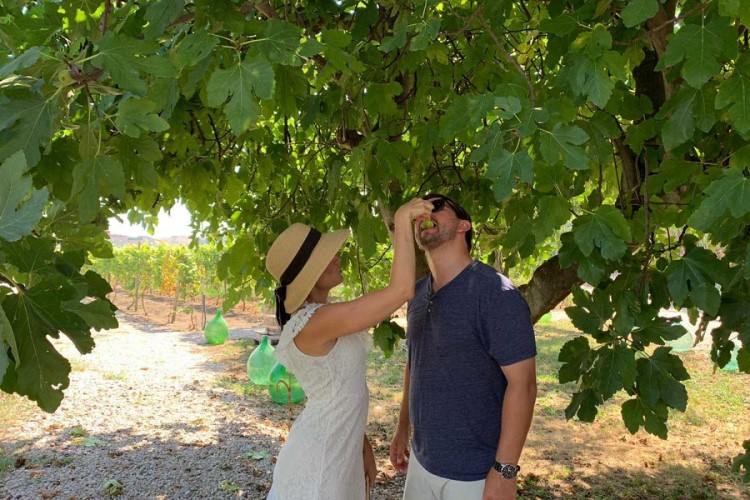An alternative tour around Pompeii
Pompeii is a jewel of archaeology heritage, a casket of the past, where its ruins tell a lot about the Ancient Romans. In addition to the ancient ruins, Pompeii is rich in cultivable fields from where some of the best fruit and vegetable products of Campania come from.
Vesuvius was for centuries considered a peaceful mountain before showing the brute eruptive power of the active volcano. Writers and poets described it as covered with vegetable gardens and vines. People venerated the mountain for its fertile land, which its volcanic origin made it particularly suitable for food crops.
Among the crop, grapes widely predominated. It was introduced by the Greeks and developed by the Romans then.
Pompeii's History through its typical dishes
In Pompeii, there is history also in its food and typical dishes. Many dishes from ancient Pompeii's cuisine have originated today's Italian recipes. Indeed, before the 79 AC eruption, Pompeii has been the first city to launch the modern concept of the restaurant.
Here opened the first Thermopylae. They were the first kind of pubs or taverns that used to offer refreshments to customers. The best example founded is the Thermopolium of Vetutius Placidus, today restored and open to the public.
Among the food used by the people of ancient Pompeii, there is the bread, of which the archaeologists founded some buried loaves. Usually, they ate it with vegetables in particular, according to the ruins, cauliflower. The fruit was essential: often served as a starter or with the dessert.
On the Lattari Mountains, they used to cultivate, directly by the ground, olives. They preserved them in salt and vinegar for extracting fragrant oil.
Pompeii's wine-growing culture
Greeks introduced the culture of wine production. They often used as a cultivation method the overripe (late vintage). In this way, the wine had a sweet and very alcoholic taste.
Indeed, they rarely drunk pure wine, but they usually diluted it with honey and served it during the symposiums. So, considering the too sweet flavour, the Greeks decided to salt the wine and, for the first time, introduced the vinification method into clay containers, useful during the liquid transports.
Under the Roman Empire, the Campania wines became the most important and appreciated in the world; the Vesuvius wines were exported in every Mediterranean city. The ancient Villae Rusticae of Pompeii were spaces used for wine and oil production (for example, Villa Regina in Boscoreale).
After the terrible eruption in 79 AC and the many following others, inevitably, the area unpopulated. Wine culture returned in the Middle Age thanks to the construction of the first churches and monasteries on the slopes of Vesuvius: the monks, helped by the peasants of the area, restarted to produce wine and were the first to vinify the famous Lacryma Christi.
The products of Pompeii and Vesuvius fields
In these volcanic fields grow some of the best products that distinguish the Neapolitan cuisine. Vesuvius area is an extraordinary mine of high quality and typical agricultural products.
First of all, is the Vesuvius DOP Piennolo cherry tomato. It is a little tomato in the shape of a lightbulb: oval with a slightly pointed apex. Its name Piennolo means "grape" in Neapolitan because it grows in this way into the Vesuvius National Park. Thanks to the quality of the terrain (near the sea), this cherry tomato is rich in mineral salts. It is an ingredient for many traditional dishes, both meat and fish, pasta and pizza. You can taste it also fresh on the bread with oil and salt.
Typical of the Vesuvius lands are the Vesuvius apricots. Their production gave rice in the 4th century. In 1583, the Neapolitan scientist Giovan Battista Della Porta distinguished them into two groups: Bericocche (round-shaped and white and soft pulp that adheres to the core) and Chisomele (the pulp doesn't adhere to the core and the fruit, bright colour, sweet taste and high quality). Anyway, most of the Neapolitans don't make the distinction and call both Crisommole. They mature from the end of May to the end of July. The many varieties distinguish each other for dimension, the intensity of the aroma, smoothness of the skin and flavour.
In Pompeii's land is also cultivated the Pompeii white onion. It is small-medium sized onion, flattened shape at the poles, white pulp and outer sheaths with light green shades. The harvest is in Spring, from March to June, and you can buy it in bunches. You can eat it fresh for deeply tasting its intense flavour. Otherwise, you can use it for preparing preserves.
The Vines of Pompeii
Into the burning heart of Vesuvius is kept the secret of its wines. Indeed, the volcanic terrains are among the best for the crop of the vine and high-quality wine production.
Among its native grapes, there are many varieties. Black grapes:
- Aglianico: it is the prince of the black grape in South Italy, the last one to grow on the slopes of Vesuvius (between the second half and the end of October). It has an intense ruby colour with garnet-orange reflections after its ageing. Its aromas remember its vineyard, with the flavour of ripe plum, violet, tobacco, spices and black pepper. It goes well with complex pasta dishes, semi-seasoned cheese, bush and red meat dishes. The perfect match is with the Sant'Anastasia kid.
- Piedirosso: Second only to Aglianico, locally it is called Palummina o per’ e Palummo (Pigeon foot). It has an intense ruby colour. It has a medium intensity fruity aroma, with frequent mineral cues typical of volcanic terrain, rich in silt, phosphorus and potassium. It goes well with seafood and vegetarian cuisine, pasta and all other dishes with tomato (perfect with ragù).
- Olivella: locally called Ulivella or Livella, because it remembers olive both in the shape and green colour. It is one of the oldest vines in Campania: it survived the devastation of phylloxera, has good resistance to adverse climatic conditions, sprouts quickly and matures in the second half of October. It has low-alcohol counterparts. It has an intense ruby colour with a purple edge, sometimes with red fermentation. Its scent of wine, fruity hints of black plum, cherry and blackberry.
Among the white grapes, there is Falanghina. It is the vine most widespread in the area of Naples. On Vesuvius, it is mainly used for Lacryma Christi, particularly for the spumante type, because of its acidity. This variety has many analogies with the Neapolitan Falanghina in Campi Flegrei, like its round grape, but it is different for the greater compactness of its bunches.
Tasting Tour Pompeii in Bosco de’ Medici Winery
On the slopes of Vesuvius, not far from the Archaeological Site, Bosco de' Medici Winery offers a tour where you will discover the flavour and the history of this area.
They have a legacy of previous generations that has its roots in the early years of the '900 for the passion of grandfather Raffaele, pushed the nephews, Emiddia, Sonia, Lella and Giuseppe. From the first wine-making experiments in the wine cellar of an eighteenth-century farmhouse (property of the family) to the construction of Hotel Diana (in the centre of Pompeii) and the Horse School, the Bosco de’ Medici estate came to life.
In 1996 the Agricultural Company was founded. In 2014, they found the Winery and start the wine production of Bosco de 'Medici. Today the Winery is the flagship of the Company, a place inspired by the passion for viticulture and wine, a place that, as grandfather Raffaele wished, recalls the noble “art” of Roman Otium. This is a place designed as a multifunctional “container” of activities ranging from production to reception.
The Palomba family lets you experience the culinary art of the territory, is proud to offer the products from their organic garden and lands owned on Vesuvius, expertly crafted by the chef Gioacchino Nocera. Some dishes follow old recipes, handed down by great grandmother Colomba to Grandma Emiddia and then to her grandchildren.
During their Tasting Tour Pompeii, you will:
- Taste their wines: their excellent sommeliers will guide you in the tasting of the company's wines. You will discover the proper Vesuvian wine!
- Tour of vineyards: An experimental tour, during which the knowledgeable guides will show you the results of the biodynamic project.
- Visit the 18th-century farmhouse and archaeological site: You will be able to visit an eighteenth-century farmhouse and cross the small necropolis of Porta Sarno dated II century BC - 1st century AD.
- Visit Cellar and Amphoraia: You will discover the rooms where our wines take shape and the project of wine in amphora.
An experience with deep historical and family roots, that if you love Italian food, visit Pompeii could be the right moment to come.
















Lascia un commento